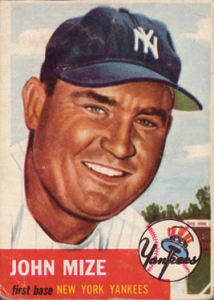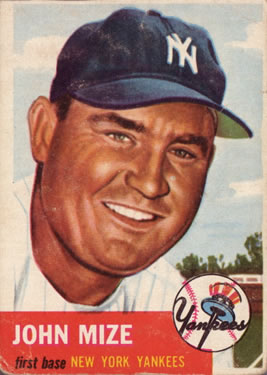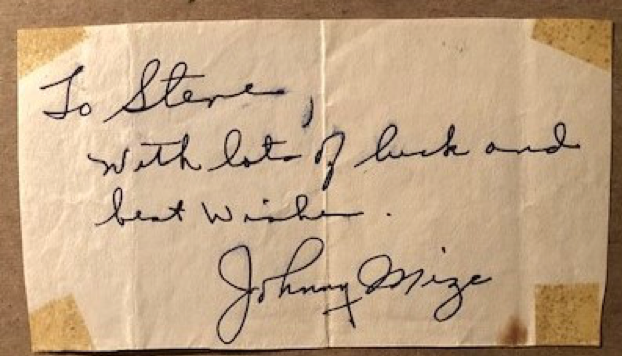September 13, 1953: Johnny Mize’s final home run beats Indians
“How good a hitter was Mize? He was Lou Gehrig good. He was Stan Musial good. He was Mel Ott good, Frank Robinson good, Joe DiMaggio good, Albert Pujols good.” — Joe Posnanski1
 Johnny Mize loved to hit a baseball, and he wrote about it in his 1953 book, How to Hit, published primarily for ages 8 to 18 during his 15th and final season in the major leagues.2 The New York Times Book Review noted that Mize’s advice to just meet the ball doesn’t mean swinging for the fences.3 Rather, Mize focuses on the fundamentals and the traits of self-confidence and determination that made him a Hall of Fame big leaguer.
Johnny Mize loved to hit a baseball, and he wrote about it in his 1953 book, How to Hit, published primarily for ages 8 to 18 during his 15th and final season in the major leagues.2 The New York Times Book Review noted that Mize’s advice to just meet the ball doesn’t mean swinging for the fences.3 Rather, Mize focuses on the fundamentals and the traits of self-confidence and determination that made him a Hall of Fame big leaguer.
Tucked away at the end of the book is a chapter highlighting his biggest thrills as a player. Call them round-trippers, four-baggers, dingers, taters, or long balls, Mize loved to hit home runs.4 They are among his fondest memories. Six times Mize swatted his way to three-home-run games, a major-league record subsequently tied by Sammy Sosa (2002) and Mookie Betts (2020). How about his three biggest thrills?
Big thrill number one occurred in 1949 in Mize’s very first World Series, between his New York Yankees and the Brooklyn Dodgers. Game Three at Ebbets Field, top of the ninth inning, bases loaded, score tied 1-1. Casey Stengel sent Mize, injured shoulder and all, to pinch-hit for right fielder Cliff Mapes. Mize hit a 2-and-1 fastball off the right-field screen and two runs scored. The Yankees won 4-3 to take the Series lead, 2-1.5
Next was a grand slam at Griffith Stadium against Walt Masterson of the Washington Senators in 1952 to complete his unparalleled homer-in-every-ballpark feat, 15 ballparks in all.6
Big thrill number three came in Game Five of the Yankees-Dodgers 1952 World Series.7 In the fifth inning, Mize hit a home run against Carl Erskine, his third in three games. He nearly hit another in the 11th inning except for Carl Furillo’s leaping catch against the right-field wall. The Yankees lost the game but won the Series in seven games and Mize was named the most valuable player.
Years later, Mize reaffirmed that indeed Game Five was the highlight of his career: “I guess the day I just missed getting four home runs in three Series games was the most memorable for me.”8
Oh, how Johnny Mize loved to hit home runs! So we need to tell the story of his 359th and last one in the big leagues, in the final month of the 1953 season. Joe Collins was now the Yankees’ regular first baseman, and Mize was almost exclusively used as a pinch-hitter, having last started a game at first base seven weeks earlier.
It wasn’t much of a pennant race in the American League. The Yankees had swept four games in Cleveland in June as part of an 18-game win streak. By then, New York had a 10½-game lead. Seeking their fifth World Series championship in a row, the Yankees held off the Chicago White Sox in June and July, and with two weeks remaining in the regular season, the Indians stood in second place, 11 games behind the Yankees. They sent Mike Garcia (17-8, 3.10 ERA) to the mound to oppose Vic Raschi (12-5, 3.55 ERA).
The Yankees struck first in the opening inning. After Garcia struck out the leadoff batter, Gil McDougald, Collins hit his 17th home run of the season into the right-field stands. The Yankees led 1-0, but not for long. Larry Doby tied the score in the second with a prodigious blast off the upper-deck façade in right field, his 24th homer of the season.
Doby wasn’t done. In the fourth inning, he hit one even farther to give the Indians a temporary one-run lead. His 25th home run landed in the bleachers in right-center, just over the 407-foot mark.
The Yankees answered in the fourth. With one out, Mickey Mantle walked. He was forced at second base on Gene Woodling’s infield grounder. Billy Martin caught third baseman Al Rosen flat-footed, dropping a bunt single to advance Woodling.9 Phil Rizzuto lined a single to center, scoring Woodling to tie the game at 2-2.
The Yankees had other opportunities in the middle innings against Garcia but failed to capitalize. In the fifth, singles by Collins and Hank Bauer and a two-out walk to Mantle loaded the bases, but Garcia struck out Woodling. With one out in the sixth, Rizzuto singled to left and stole second. Garcia struck out Raschi and retired McDougald on a fly ball to right to end that threat.
Meanwhile, Raschi held the Indians hitless in the middle innings although he yielded three walks. A leadoff walk to Doby in the seventh seemed justified after his two home runs. Doby was sacrificed to second by Wally Westlake, but remained there when Raschi retired the side.
In the eighth, however, Raschi weakened. Bobby Avila and Bill Glynn opened with singles. After a groundball back to the pitcher forced Avila at third, Al Rosen singled to left, scoring Glynn, and the Indians led by one run.
After Westlake made a beautiful sliding catch of Mantle’s bid for a leadoff hit in the bottom of the eighth,10 Woodling hit his 10th homer of the season into the right-field bleachers to tie the score again, 3-3. The Yankees kept going. Martin singled to center and Rizzuto was safe when Rosen threw wide to first on an infield grounder.
Stengel always seemed to know the opportune time to bring Mize into the game as a pinch-hitter. This time, batting for Raschi, Mize hit Garcia’s first pitch into the right-field stands, and the Yankees led 6-3. Mize’s home run was his 19th pinch hit of the season, leaving him one short of the American League record of 20 set by the St. Louis Browns’ Ed Coleman in 1936.11
Johnny Sain pitched the ninth inning for the Yankees. He faced the tying run at the plate with two outs, but retired Avila on a grounder, closing out the game and giving the Yankees a magic number of two to clinch the American League pennant. The Yankees coasted for the next two weeks to finish 8½ games ahead of the second-place Indians, their third consecutive season as runner-up.
Mize, fondly nicknamed ‘The Big Cat,” was finishing his 15-year career with Hall of Fame-worthy numbers – .312 batting average, 2,011 hits, 359 home runs and 1,337 runs batted in. He was now number six on the career home-run list – Ruth, Foxx, Ott, Gehrig, DiMaggio, then Mize.12
The 48,492 fans at Yankee Stadium on this Sunday afternoon in September were truly fortunate. The Yankees honored Marine fighter pilot and second baseman Jerry Coleman, the only major-league player to see combat duty in both World War II and the Korean War.13 Perhaps some were watching the 40-year old Mize play baseball for the first time. They were the lucky ones. They got to see him do what he loved to do, hit a home run, for the last time.
Mize and the Yankees were now going to another World Series against the Brooklyn Dodgers. The Yankees won the World Series in six games but the story for Mize was very much different than in 1952. He failed to get a hit in three pinch-hitting appearances. In fact, Carl Erskine struck out Mize in the ninth inning of Game Three to finish a 14-strikeout record-setting performance.14
How good was Johnny Mize? Just ask another ballplayer, Cleveland Indians’ All-Star third baseman Al Rosen, the American League’s unanimous choice for Most Valuable Player in 1953. Rosen always wanted to be as good as he possibly could. He was asked at that time how long he would play baseball. “If I find myself going downhill one of these years, I think I’ll quit. I wouldn’t mind if I were Johnny Mize, but the Mizes are few and far between.”15 Indeed.
Author’s note
This essay completes a series of four that tells a story about the Yankee years in the baseball career of Johnny Mize. The reader is referred to the other SABR Games Project postings:
- July 18, 1950: Johnny Mize homers twice, Yankees crush Browns
- September 7, 1952: Johnny Mize completes homer-in-every-ballpark with pinch-hit grand slam
- October 5, 1952: Duke Snider hits and Carl Erskine pitches Dodgers to World Series lead in Game Five
Why write essays about Johnny Mize in the later stages of his career? Those Yankee years had a special significance for Big Jawn – five World Series in five seasons in the pinstripes. For the author, this was a good way to say thank you to Mr. Mize for that precious first autograph on a scrap of paper.
Acknowledgments
This essay was fact-checked Kevin Larkin and copy-edited by Len Levin.
Sources
The author accessed Retrosheet.org (retrosheet.org/boxesetc/1953/B09130NYA1953.htm), Baseball-Reference.com (baseball-reference.com/boxes/NYA/NYA195309130.shtml), and Baseball-Almanac.com (baseball-almanac.com/recbooks/rb_hr9.shtml) for box scores/play-by-play and other data. The 1953 Topps baseball card for Johnny Mize (#77) was obtained from the Trading Card Database.
Notes
1 Joe Posnanski, The Baseball 100 (New York: Simon & Schuster, 2021), 235.
2 Johnny Mize as told to Murray Kaufman, How to Hit (New York: Henry Holt and Company, 1953).
3 George A. Woods, “Hits and Runs,” New York Times, April 19, 1953: BR-28.
4 Paul Dickson, The Dickson Baseball Dictionary, Third Edition (New York: W.W. Norton & Company, 2009). Synonyms for home run. For example, the etymology of round-tripper derives from “a rail or air ticket that takes one to a destination and then returns one to the point of origin.”
5 Johnny Mize as told to Murray Kaufman, How to Hit, 94. Ken Carrano, “Mize’s First World Series Was All Right,” in Ebbets Field, Great, Historic, and Memorable Games in Brooklyn’s Lost Ballpark, ed. Gregory H. Wolf et al. (Phoenix: Society for American Baseball Research, to be published), 218.
6 Johnny Mize as told to Murray Kaufman, How to Hit, 94. Steven C. Weiner, “September 7, 1952: Johnny Mize completes homer-in-every-ballpark with pinch-hit grand slam,” SABR Baseball Games Project.
7 Steven C. Weiner, “October 5, 1952: Duke Snider hits and Carl Erskine pitches Dodgers to World Series lead in Game Five,” SABR Baseball Games Project.
8 Johnny Mize as told to George Vass, “The Game I’ll Never Forget,” Baseball Digest, March 1979: 76.
9 John Drebinger, “Bombers Triumph on Mize’s Homer,” New York Times, September 14, 1953: 30. Dickson, 330. Flat-footed: “unprepared, inattentive, asleep, not on one’s toes.”
10 Drebinger.
11 John Drebinger. Mize batted nine more times in pinch-hitting appearances for the remainder of the season but failed to get a hit (Townsend Evans, “Mize and Evans Finished Short of Pinch-Hit Marks,” The Sporting News, October 7, 1953: 10). Through the 2022 season, the American League record of pinch-hits in a season is held by the Baltimore Orioles’ Dave Philley – 24 in 1961. The major-league record is held by the Colorado Rockies’ John Vander Wal – 28 in 1995. (Baseball-Almanac.com)
12 Through the 2022 season, Mize was 87th on the career home-run list.
13 Ted Williams was also a fighter pilot who served in both wars, but Williams saw combat only in Korea. Coleman played a “ceremonial” two innings in this game and was replaced by Billy Martin. Martin’s shining accomplishment would come in the World Series – 12-for-24, 2 home runs, 8 runs batted in.
14 Don Zminda, “Erskine Sets World Series Record With 14 Strikeouts,” in Gregory H. Wolf et al., eds., Ebbets Field, Great, Historic, and Memorable Games in Brooklyn’s Lost Ballpark (Phoenix: Society for American Baseball Research, to be published), 297. The record was subsequently broken by Sandy Koufax (15) in Game One of the 1963 World Series, 10 years to the day after Erskine’s performance. It took another five years to the day for Bob Gibson (17) to set the new record in Game One of the 1968 World Series.
15 Hal Lebovitz, “Tribe’s Rosen at Top on Will to Produce,” The Sporting News, September 23, 1953: 3.
Additional Stats
New York Yankees 6
Cleveland Indians 3
Yankee Stadium
New York, NY
Box Score + PBP:
Corrections? Additions?
If you can help us improve this game story, contact us.



